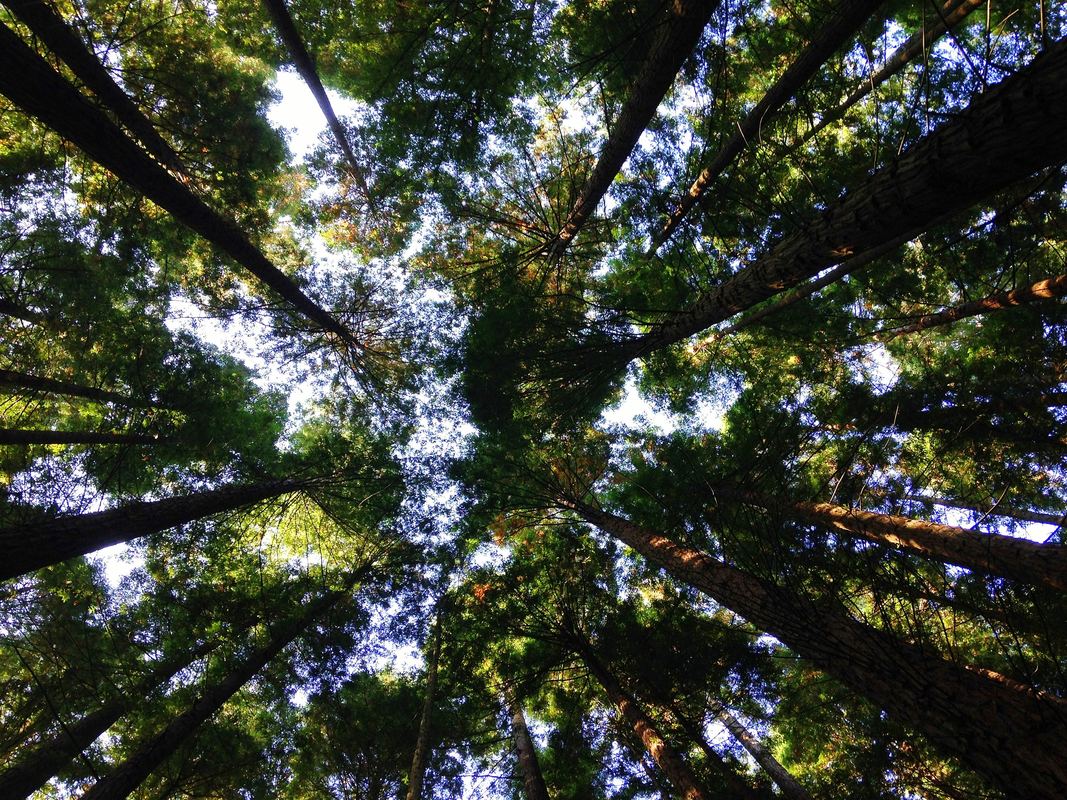|
photo credit, Angela Benito on Unsplash Just look at these fine upstanding citizens in my neighborhood. I feel good when I am among them. We all intuitively know that time spent in the company of trees relaxes us and generates a feeling of well being. But it took until the early 1990s to give it a specific name when the Japanese Ministry of Agriculture, Forestry and Fisheries coined the term Shinrin-yoku — which translates roughly as forest bathing. Could it be that forest bathing is good for us because we enter a similar environment to the 2.3 billion-year-old nexus of life's triumph over adversity? That is the time of the first mass extinction on Earth when against all odds, our ancestors and those of trees diverged. Before that we were all bacteria, feasting on nutrients and emitting oxygen as a waste product. Oxygen, in its free radical form is destructive because it robs other elements in an attempt to stabilise. The Oxygen Catastrophe en.wikipedia.org/wiki/Great_Oxygenation_Event reduced all life on Earth to scattered remnants. But life miraculously invented the ability to breathe in one of the earliest examples of the stunning creativity of an intelligent universe. Ever since, trees and plants consume our waste, carbon dioxide, and provide us with oxygen in return. We return the favor by exhaling.
Thanks to recent groundbreaking research in both North America and Europe, we now know that when we enter a forest, we are in a community. That tree society is capable of communicating among themselves, providing help for the weak and afflicted and defence from attacks. Scientists are discovering astonishing things about the lives of trees that give us pause to reflect on the stunning similarities to life as we have come to know it. For instance, in just the last few decades, research uncovered the wood wide web. This is an ancient (450 million-year-old) symbiotic relationship of fungi and tree roots. It is termed mycorrhiza, which like the name, reflects a growing-together of the Greek words for fungus (mykós) and root (riza). The mycorrhiza facilitates a mutually beneficial arrangement of food donations in the form of carbon or sugar that trees gain through photosynthesis to be traded for other nutrients like phosphorus and nitrogen, which the fungi extracts from the soil with enzymes the tree lacks. The most incredible revelation about the wood wide web is that it is not only a resource sharing mechanism among trees but also a communication superhighway. If one tree is under attack by insects, for instance, it can raise an alarm through this network to other trees. Those forewarned trees raise their defences with chemicals that taste bad to the invaders. After 30 years of research in Canadian forests, ecologist Suzanne Simard states, "Trees talk, often and over vast distances." In other words, trees have their own social network. Over the wood wide web, they use electrical signals from their root tips underground for a myriad of purposes. Admittedly, the signals travel very slowly, about a third of an inch per second, but they help trees exchange information about insects, drought and other dangers. Peter Wohlleban, a forester from Germany, wrote an astonishing book, The Hidden Life of Trees, which became a bestseller in Germany and went on to become an International Bestseller. He says "trees are quite similar to human families, the parents live together with their children, communicate with them, support them as they grow, share nutrients with those who are sick and struggling and even warn each other of impending dangers." A mother tree recognises it's kin and selectively attends to their needs over other trees that are not related. In addition to the mycorrhizal network, we have known for quite a while that trees have other ways of communicating, through scent. It has been conclusively shown that acacia trees emit a pheromone scent, ethylene, when being feasted upon by giraffes to signal other trees in the vicinity. The giraffes bypass the bitter leaves of the fore-warned neighbors in favour of those from trees who are upwind and unwary of the threat. These exciting revelations raise big questions about the line we draw between ourselves and other species. We elevate ourselves above nature and view it as a vast storehouse to be utilised at our discretion. The next time we take a forest bath, let's pause and take a big breath and allow this astonishing knowledge to penetrate us. These species lives are inextricably twined together with ours -- they provide us with the raw material for our next breath! In addition, they care for their kin and their extended community and find ways to assist them. In short, we share many of the same qualities.
2 Comments
I read the alarming news about Capetown, South Africa, one of the world's most affluent cities, with a sense of foreboding. news.nationalgeographic.com/2018/02/cape-town-running-out-of-water-drought-taps-shutoff-other-cities/ A new term has been coined to refer to the problem there. Day Zero. That is the day that all the taps in the region will be shut off. From that point on, water will be distributed from one of 200 emergency water stations outside groceries and other gathering places. Residents will be forced to queue up surrounded by armed guards to collect enough water for their needs. Day Zero was going to be February 5th, 2018. They got a slight reprieve because agriculture had already used their allotment this year, so it has been postponed until May 11th. Officials say Day Zero in Capetown is inevitable. "The question that dominates my waking hours now is: When Day Zero arrives, how do we make water accessible and prevent anarchy?" says Helen Zille, former Cape Town mayor and the current premier of South Africa's Western Cape province. It is tempting to think that they were caught unprepared. But over the last 20 years, Capetown has made elaborate changes in preparation for the looming threat. It even won several prestigious international awards for water management. In 2014, all the reservoirs were full. But then came three straight years of drought, the worst in a century. All water management algorithms employ historical models to predict the future. But we are now in a perilous new environment in which climate change, extreme weather events and increased demand from burgeoning human populations are taking their toll. Capetown is not the only major city with water problems; included are Mexico City, Sao Paulo, Jakarta, and Melbourne, Australia. In addition, there are also many areas where famine and unrest are tied to a lack of water. Here in California, we have our own share of water problems. As Mark Twain once said, "Whisky's for drinkin, water's for fighting." We are made of water, our bodies are comprised of 60% water and if we don't have access to it, we probably will resort to fighting. Water is Life. Our predecessors crawled up out of it millions of years ago with a vascular system that carries it to every part of our bodies. We have lived too long in the lap of luxury with water flowing from ubiquitous taps everywhere. Our presumed continued access to clean water could prove to be our Achilles heel. We haven't caught up on the dismaying news that clean fresh water is no longer guaranteed and we may need to plan for that eventuality.
The human imagination is also ripe with resourcefulness. Consider the possibility of "Fog Collection" en.wikipedia.org/wiki/Fog_collection. There is evidence of ancient practices of a version of this in medieval dew ponds in Southern England, antique stone piles in the Ukraine and large scale natural irrigation in the Atacama and Namib deserts. Modern day fog collection is simply accomplished by stretching a large piece of canvas between two poles. Water droplets coalesce and run down into a collection trough below. A good example of this occurred in the eighties by the meteorological service of Canada (MSC) with the construction of large collecting devices on Mount Sutton in Quebec. Chilean authorities learned of it and erected 50 of the systems to irrigate seedlings on a hillside in an attempt at reforestation. It's proven success elicited a request from the villagers below and funding from the IRDC (International Development Research Centre). It was expanded to 94 collection devices, a storage tank and piping to the village. Initially, it was considered to be a spectacular success, with an average production of 15,000 litres of water per day (peaking at 100,000 liters) that could be stored or piped to the village for use in drinking, bathing and irrigating. Other successful implementations of this low tech water harvesting method have also occurred in Guatemala, Morocco, Yemen, Haiti, and Nepal. Another inspiring example of a simple water conservation method is the story of a farmer, Pak Sadiman, from Central Java, Indonesia www.thejakartapost.com/news/2015/09/01/man-spends-19-years-planting-trees-save-village-drought.html. He spent nineteen years of his spare time planting Banyan and Lamtoro trees on a denuded hillside. The hill was severely deforested through logging and a series of forest fires that took place between the 1960's and 80's. As a result, the Gendol river, which used to be the only source of water for villagers, completely dried up. While thirty other districts in the region are still suffering from the water shortages, his local Geneng district has been unaffected by the prolonged dry season. The Banyan and Lamtoro trees he planted have the effect of retaining groundwater. Sadiman says he can't remember how many trees he has planted but data from the subdistrict office indicates that at least 11,000 trees have been planted in the last 19 years. Locals are quoted, "Pak Sadiman is our hero. This village used to struggle with a water crisis, but now we have an abundance of water because of him. Pak Sadiman is a living example of sincerity, persistence and hard work." Sadiman, age 67, says he intends to plant at least 20,000 more trees on the Gendol and Ampyangan hills to further alleviate the current water deficit and ensure that all neighboring subdistricts also get enough clean water. "I won't stop planting trees as long as I'm still physically fit to do that," he said. Photo credit, Mitchell Clute I've been bathing in moonbeams. Just the other day, I looked up into the bright afternoon sky and there it was in all its glory. Just like the song I sang as a child, the "bright and shiny moon" was shining down on me, but in the middle of the day. The dark side of the moon was visible too, lurking in the shadow behind. I never saw the moon like this before. It appeared ripe, as if it was pregnant. The sight aroused a quickening deep inside me. It was so big, I imagined myself reaching up to pluck it right out of the sky. A visceral "heavenly body" experience is a blessing beyond measure.
In just a few more days, the Super Blue Blood Moon was upon us. I awakened early the morning of January 31st to see the partial eclipse moving swiftly towards the unveiling of the entire radiant orb just before it set. Watching this celestial wonder unfold filled me with awe while I contemplated the State of the Union, the State of the World. The shadow of Earth on the Moon helped me to clarify, we are moving through a dark time, full of uncertainty and fear. But the shadow play cleared the way for beauty to re-emerge and we can too. This chaos is necessary because it is stimulating a potent healing response. We are living through a massive paradigm shift and at this point, there is no way out but through. This cosmic event was double lucky for me since the full moon takes a full twenty four hour period. I was given another gift early this morning when I awakened again and saw my first "moon bow." I sat in the rainbow of moonbeams for a while and allowed myself to be overwhelmed by feelings of well being and gratitude. What an miraculous universe we share! Let's get down to the business of seeing ourselves as one Earth family and taking care of our beautiful garden. We can expand beyond our differences by focusing on what binds us together. Ponder this. Trees and plants eat the sun and manufacture oxygen for us to breathe. Along with us, countless non-human others, the four-leggeds, winged ones and crawling creatures return the favour by exhaling. This is our priceless inheritance and we must rise above these human centred conflicts and work together to preserve it. Humans are responsible for many of the problems Earth faces, while we are also the only ones who can provide the solution. The whole world is waiting in breathless beauty for us. |
AuthorMy passion is my bond with animals and love and appreciation for our home, Earth. I make cast glass sculpture and nature is my muse. Archives
August 2020
Categories |





 RSS Feed
RSS Feed